Corporate Social Responsibility in the Restaurant Sector
VerifiedAdded on 2020/05/08
|31
|6133
|41
AI Summary
The food and beverage industry is a dynamic field impacted by multiple factors such as regulatory frameworks, ingredient innovations like collagen, and sustainable operations. This document provides an analysis covering non-regulatory food safety schemes implemented in New Zealand, exploring their effectiveness within the local food industry. Additionally, it delves into the use of industrial enzymes in food production, highlighting methods for scaling up processes. The study also examines sustainability practices within hospitality management, outlining principles that enhance operational efficiency and environmental stewardship. Furthermore, corporate social responsibility (CSR) initiatives are analyzed concerning their influence on brand equity and customer relations in restaurants. Lastly, insights into the role of collagen as a valuable ingredient in food and beverage products are discussed.
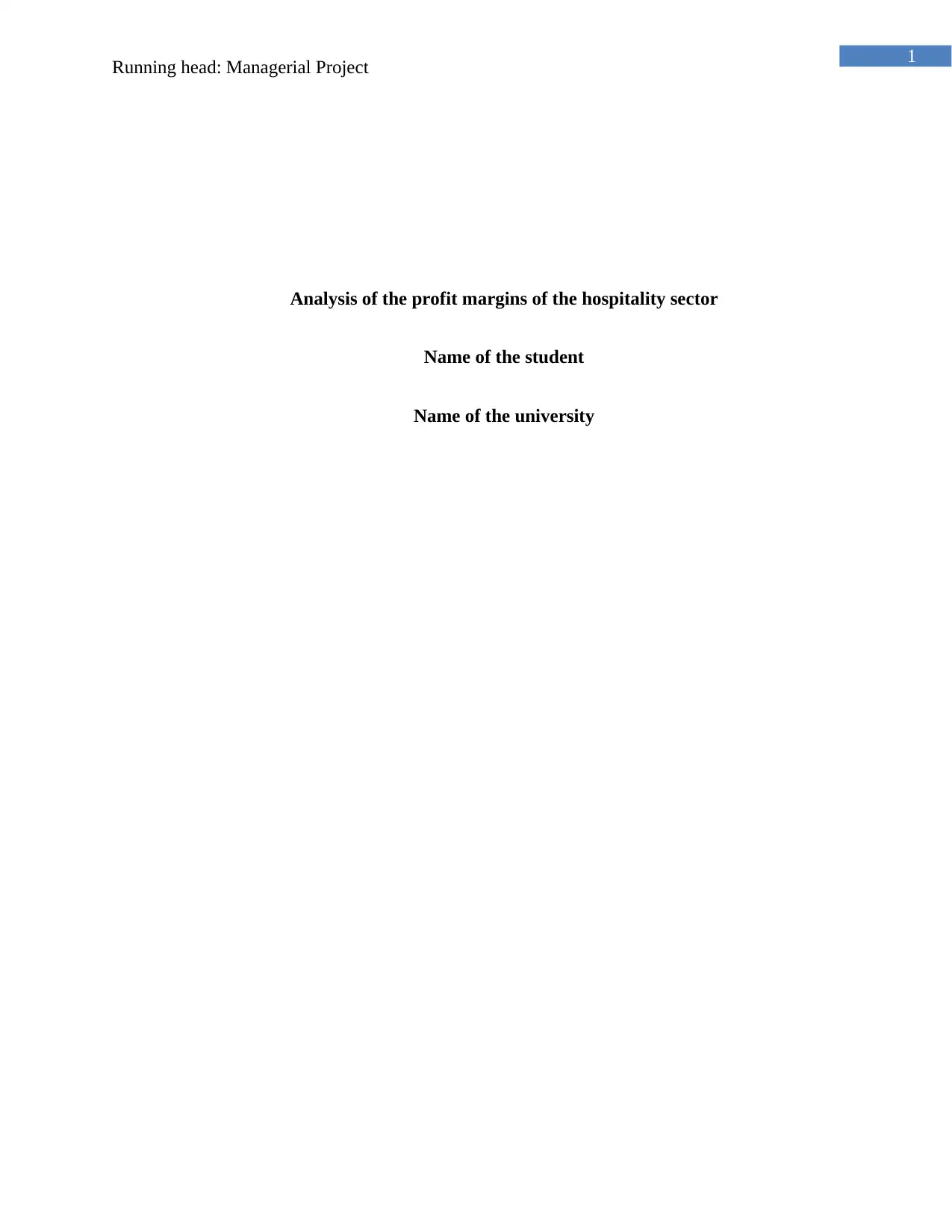
1
Running head: Managerial Project
Analysis of the profit margins of the hospitality sector
Name of the student
Name of the university
Running head: Managerial Project
Analysis of the profit margins of the hospitality sector
Name of the student
Name of the university
Paraphrase This Document
Need a fresh take? Get an instant paraphrase of this document with our AI Paraphraser
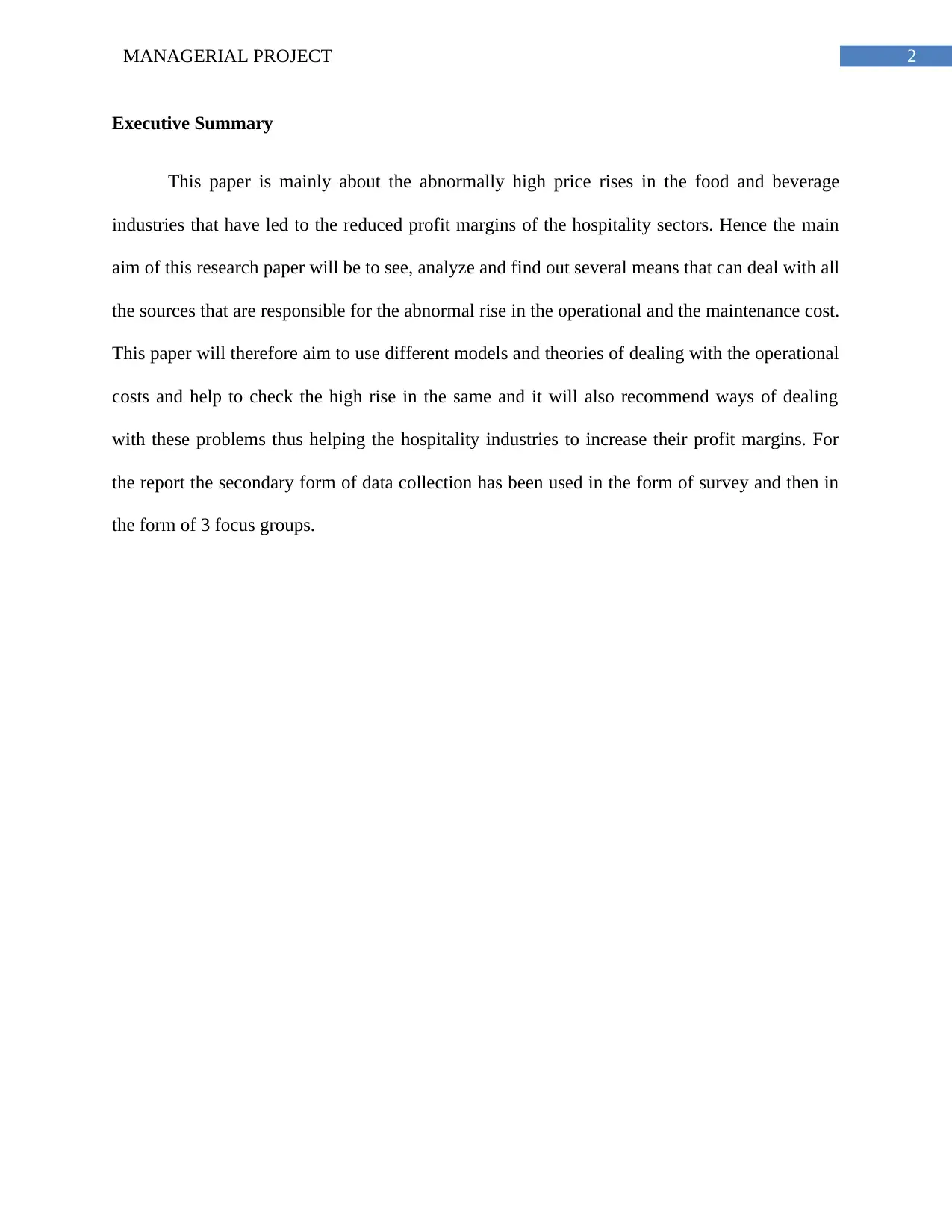
2MANAGERIAL PROJECT
Executive Summary
This paper is mainly about the abnormally high price rises in the food and beverage
industries that have led to the reduced profit margins of the hospitality sectors. Hence the main
aim of this research paper will be to see, analyze and find out several means that can deal with all
the sources that are responsible for the abnormal rise in the operational and the maintenance cost.
This paper will therefore aim to use different models and theories of dealing with the operational
costs and help to check the high rise in the same and it will also recommend ways of dealing
with these problems thus helping the hospitality industries to increase their profit margins. For
the report the secondary form of data collection has been used in the form of survey and then in
the form of 3 focus groups.
Executive Summary
This paper is mainly about the abnormally high price rises in the food and beverage
industries that have led to the reduced profit margins of the hospitality sectors. Hence the main
aim of this research paper will be to see, analyze and find out several means that can deal with all
the sources that are responsible for the abnormal rise in the operational and the maintenance cost.
This paper will therefore aim to use different models and theories of dealing with the operational
costs and help to check the high rise in the same and it will also recommend ways of dealing
with these problems thus helping the hospitality industries to increase their profit margins. For
the report the secondary form of data collection has been used in the form of survey and then in
the form of 3 focus groups.
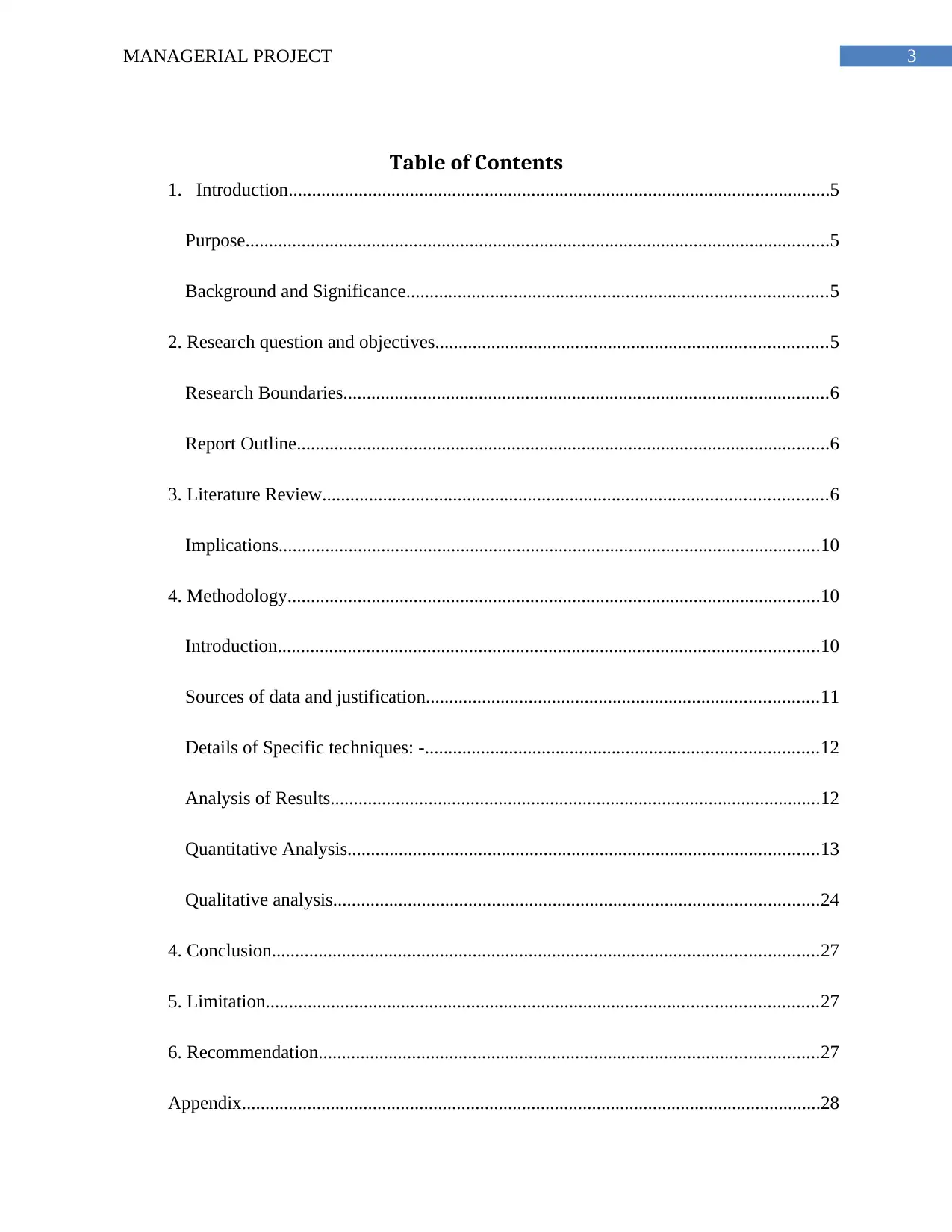
3MANAGERIAL PROJECT
Table of Contents
1. Introduction....................................................................................................................5
Purpose.............................................................................................................................5
Background and Significance..........................................................................................5
2. Research question and objectives....................................................................................5
Research Boundaries........................................................................................................6
Report Outline..................................................................................................................6
3. Literature Review............................................................................................................6
Implications....................................................................................................................10
4. Methodology..................................................................................................................10
Introduction....................................................................................................................10
Sources of data and justification....................................................................................11
Details of Specific techniques: -....................................................................................12
Analysis of Results.........................................................................................................12
Quantitative Analysis.....................................................................................................13
Qualitative analysis........................................................................................................24
4. Conclusion.....................................................................................................................27
5. Limitation......................................................................................................................27
6. Recommendation...........................................................................................................27
Appendix............................................................................................................................28
Table of Contents
1. Introduction....................................................................................................................5
Purpose.............................................................................................................................5
Background and Significance..........................................................................................5
2. Research question and objectives....................................................................................5
Research Boundaries........................................................................................................6
Report Outline..................................................................................................................6
3. Literature Review............................................................................................................6
Implications....................................................................................................................10
4. Methodology..................................................................................................................10
Introduction....................................................................................................................10
Sources of data and justification....................................................................................11
Details of Specific techniques: -....................................................................................12
Analysis of Results.........................................................................................................12
Quantitative Analysis.....................................................................................................13
Qualitative analysis........................................................................................................24
4. Conclusion.....................................................................................................................27
5. Limitation......................................................................................................................27
6. Recommendation...........................................................................................................27
Appendix............................................................................................................................28
⊘ This is a preview!⊘
Do you want full access?
Subscribe today to unlock all pages.

Trusted by 1+ million students worldwide
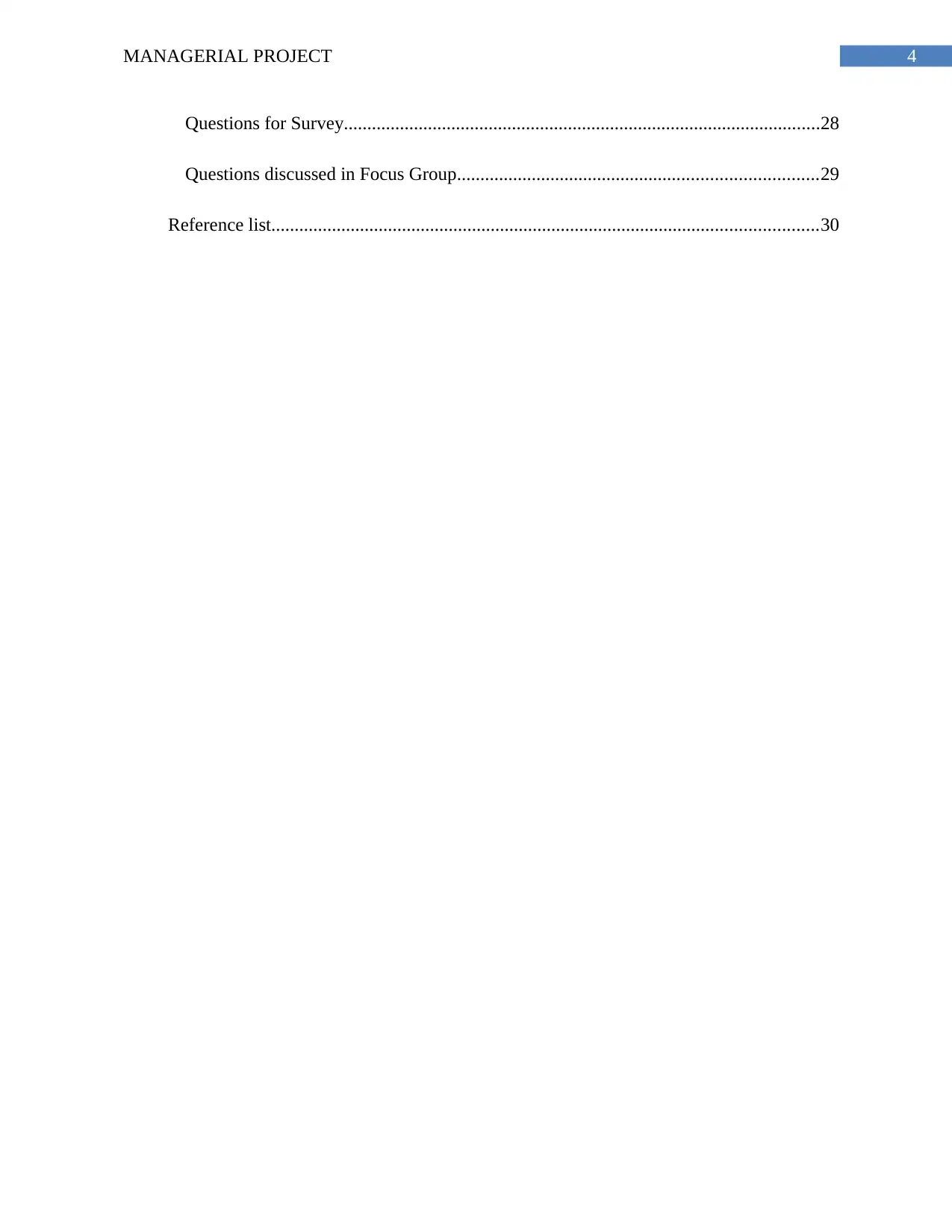
4MANAGERIAL PROJECT
Questions for Survey......................................................................................................28
Questions discussed in Focus Group.............................................................................29
Reference list.....................................................................................................................30
Questions for Survey......................................................................................................28
Questions discussed in Focus Group.............................................................................29
Reference list.....................................................................................................................30
Paraphrase This Document
Need a fresh take? Get an instant paraphrase of this document with our AI Paraphraser
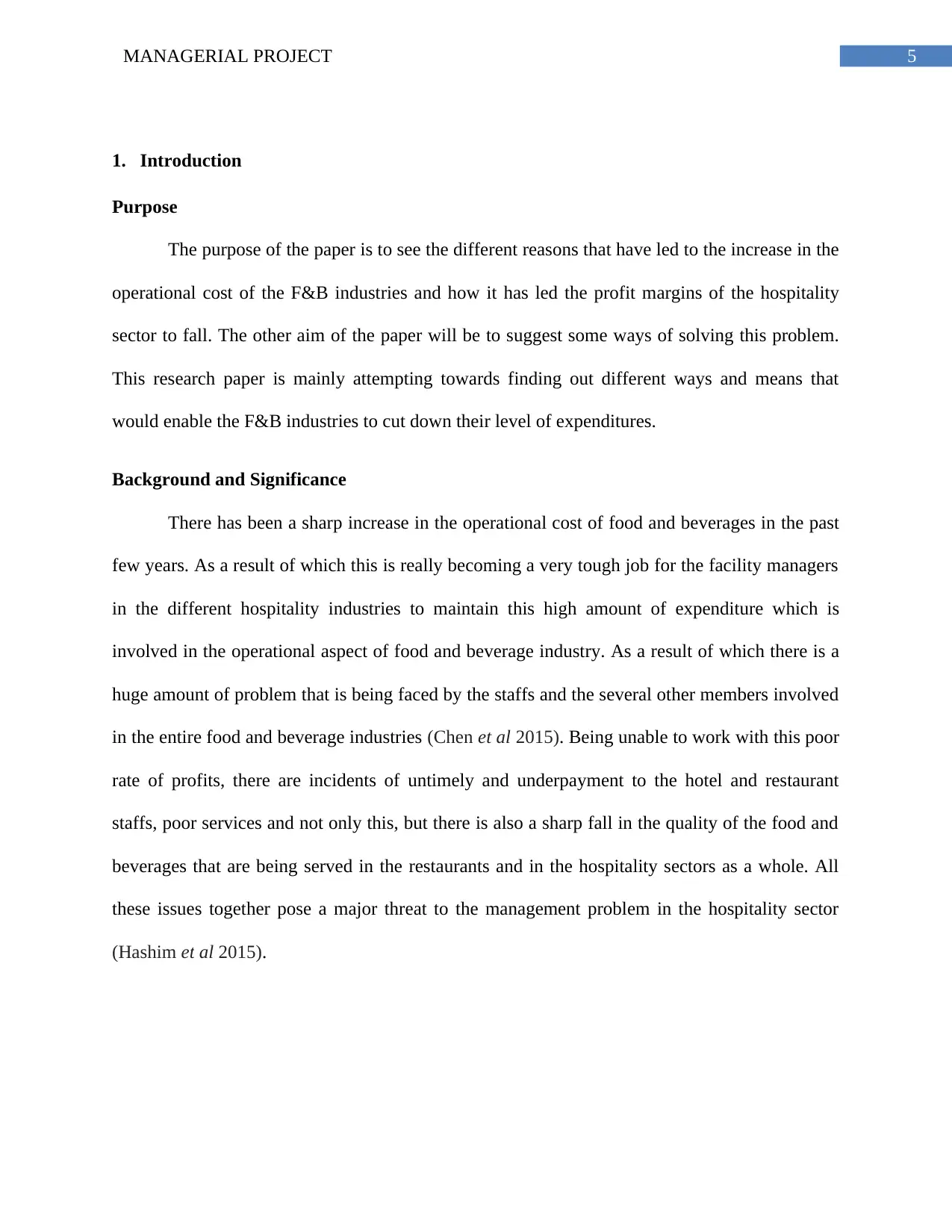
5MANAGERIAL PROJECT
1. Introduction
Purpose
The purpose of the paper is to see the different reasons that have led to the increase in the
operational cost of the F&B industries and how it has led the profit margins of the hospitality
sector to fall. The other aim of the paper will be to suggest some ways of solving this problem.
This research paper is mainly attempting towards finding out different ways and means that
would enable the F&B industries to cut down their level of expenditures.
Background and Significance
There has been a sharp increase in the operational cost of food and beverages in the past
few years. As a result of which this is really becoming a very tough job for the facility managers
in the different hospitality industries to maintain this high amount of expenditure which is
involved in the operational aspect of food and beverage industry. As a result of which there is a
huge amount of problem that is being faced by the staffs and the several other members involved
in the entire food and beverage industries (Chen et al 2015). Being unable to work with this poor
rate of profits, there are incidents of untimely and underpayment to the hotel and restaurant
staffs, poor services and not only this, but there is also a sharp fall in the quality of the food and
beverages that are being served in the restaurants and in the hospitality sectors as a whole. All
these issues together pose a major threat to the management problem in the hospitality sector
(Hashim et al 2015).
1. Introduction
Purpose
The purpose of the paper is to see the different reasons that have led to the increase in the
operational cost of the F&B industries and how it has led the profit margins of the hospitality
sector to fall. The other aim of the paper will be to suggest some ways of solving this problem.
This research paper is mainly attempting towards finding out different ways and means that
would enable the F&B industries to cut down their level of expenditures.
Background and Significance
There has been a sharp increase in the operational cost of food and beverages in the past
few years. As a result of which this is really becoming a very tough job for the facility managers
in the different hospitality industries to maintain this high amount of expenditure which is
involved in the operational aspect of food and beverage industry. As a result of which there is a
huge amount of problem that is being faced by the staffs and the several other members involved
in the entire food and beverage industries (Chen et al 2015). Being unable to work with this poor
rate of profits, there are incidents of untimely and underpayment to the hotel and restaurant
staffs, poor services and not only this, but there is also a sharp fall in the quality of the food and
beverages that are being served in the restaurants and in the hospitality sectors as a whole. All
these issues together pose a major threat to the management problem in the hospitality sector
(Hashim et al 2015).
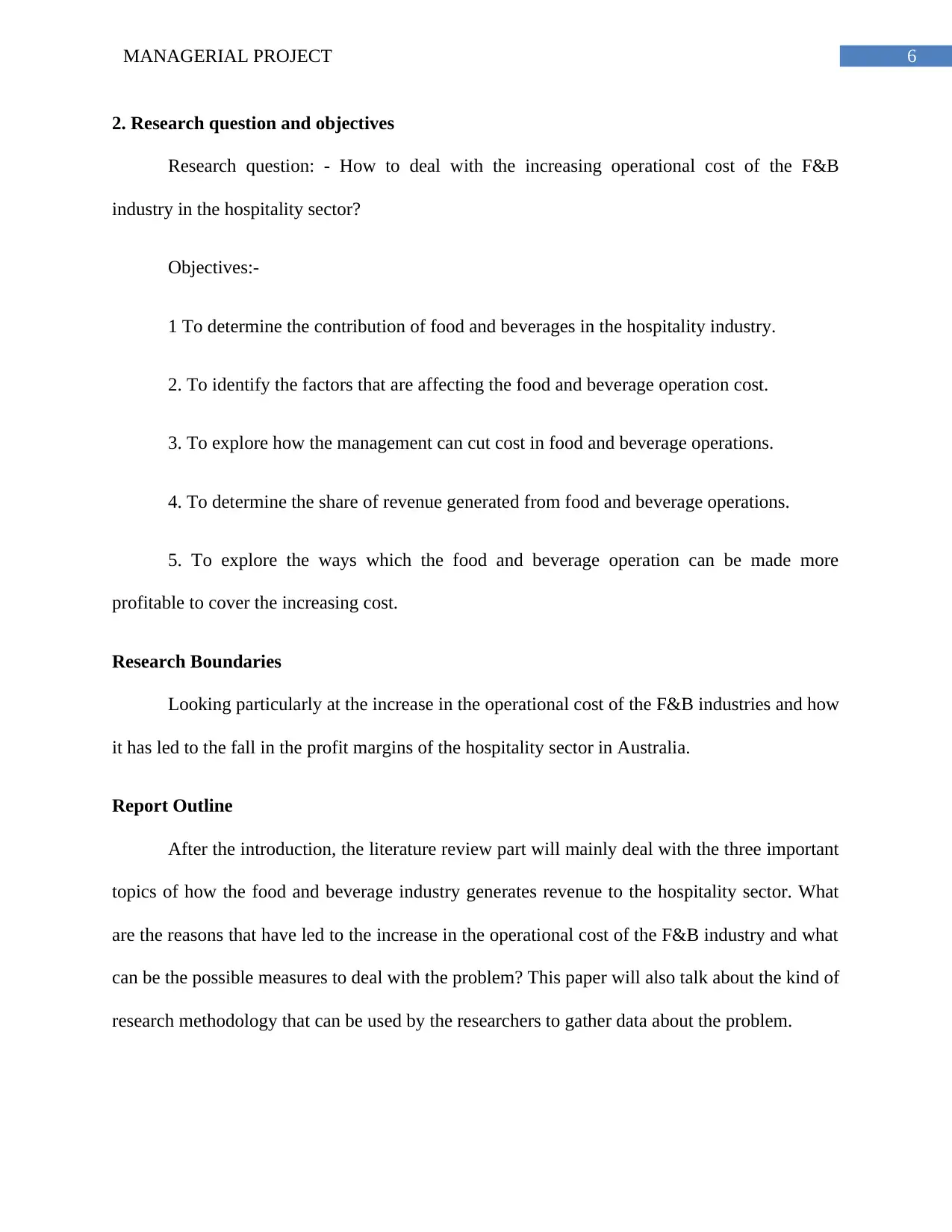
6MANAGERIAL PROJECT
2. Research question and objectives
Research question: - How to deal with the increasing operational cost of the F&B
industry in the hospitality sector?
Objectives:-
1 To determine the contribution of food and beverages in the hospitality industry.
2. To identify the factors that are affecting the food and beverage operation cost.
3. To explore how the management can cut cost in food and beverage operations.
4. To determine the share of revenue generated from food and beverage operations.
5. To explore the ways which the food and beverage operation can be made more
profitable to cover the increasing cost.
Research Boundaries
Looking particularly at the increase in the operational cost of the F&B industries and how
it has led to the fall in the profit margins of the hospitality sector in Australia.
Report Outline
After the introduction, the literature review part will mainly deal with the three important
topics of how the food and beverage industry generates revenue to the hospitality sector. What
are the reasons that have led to the increase in the operational cost of the F&B industry and what
can be the possible measures to deal with the problem? This paper will also talk about the kind of
research methodology that can be used by the researchers to gather data about the problem.
2. Research question and objectives
Research question: - How to deal with the increasing operational cost of the F&B
industry in the hospitality sector?
Objectives:-
1 To determine the contribution of food and beverages in the hospitality industry.
2. To identify the factors that are affecting the food and beverage operation cost.
3. To explore how the management can cut cost in food and beverage operations.
4. To determine the share of revenue generated from food and beverage operations.
5. To explore the ways which the food and beverage operation can be made more
profitable to cover the increasing cost.
Research Boundaries
Looking particularly at the increase in the operational cost of the F&B industries and how
it has led to the fall in the profit margins of the hospitality sector in Australia.
Report Outline
After the introduction, the literature review part will mainly deal with the three important
topics of how the food and beverage industry generates revenue to the hospitality sector. What
are the reasons that have led to the increase in the operational cost of the F&B industry and what
can be the possible measures to deal with the problem? This paper will also talk about the kind of
research methodology that can be used by the researchers to gather data about the problem.
⊘ This is a preview!⊘
Do you want full access?
Subscribe today to unlock all pages.

Trusted by 1+ million students worldwide
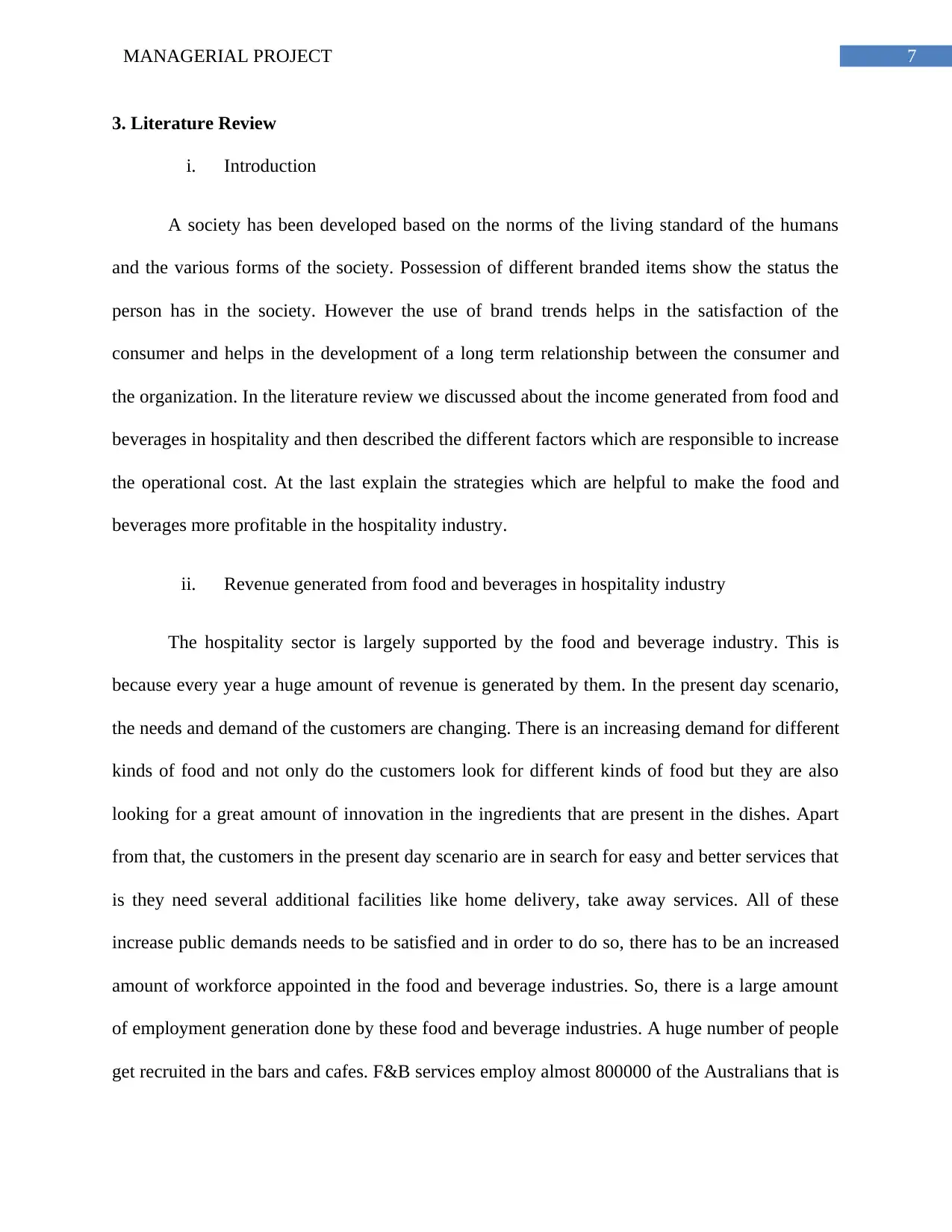
7MANAGERIAL PROJECT
3. Literature Review
i. Introduction
A society has been developed based on the norms of the living standard of the humans
and the various forms of the society. Possession of different branded items show the status the
person has in the society. However the use of brand trends helps in the satisfaction of the
consumer and helps in the development of a long term relationship between the consumer and
the organization. In the literature review we discussed about the income generated from food and
beverages in hospitality and then described the different factors which are responsible to increase
the operational cost. At the last explain the strategies which are helpful to make the food and
beverages more profitable in the hospitality industry.
ii. Revenue generated from food and beverages in hospitality industry
The hospitality sector is largely supported by the food and beverage industry. This is
because every year a huge amount of revenue is generated by them. In the present day scenario,
the needs and demand of the customers are changing. There is an increasing demand for different
kinds of food and not only do the customers look for different kinds of food but they are also
looking for a great amount of innovation in the ingredients that are present in the dishes. Apart
from that, the customers in the present day scenario are in search for easy and better services that
is they need several additional facilities like home delivery, take away services. All of these
increase public demands needs to be satisfied and in order to do so, there has to be an increased
amount of workforce appointed in the food and beverage industries. So, there is a large amount
of employment generation done by these food and beverage industries. A huge number of people
get recruited in the bars and cafes. F&B services employ almost 800000 of the Australians that is
3. Literature Review
i. Introduction
A society has been developed based on the norms of the living standard of the humans
and the various forms of the society. Possession of different branded items show the status the
person has in the society. However the use of brand trends helps in the satisfaction of the
consumer and helps in the development of a long term relationship between the consumer and
the organization. In the literature review we discussed about the income generated from food and
beverages in hospitality and then described the different factors which are responsible to increase
the operational cost. At the last explain the strategies which are helpful to make the food and
beverages more profitable in the hospitality industry.
ii. Revenue generated from food and beverages in hospitality industry
The hospitality sector is largely supported by the food and beverage industry. This is
because every year a huge amount of revenue is generated by them. In the present day scenario,
the needs and demand of the customers are changing. There is an increasing demand for different
kinds of food and not only do the customers look for different kinds of food but they are also
looking for a great amount of innovation in the ingredients that are present in the dishes. Apart
from that, the customers in the present day scenario are in search for easy and better services that
is they need several additional facilities like home delivery, take away services. All of these
increase public demands needs to be satisfied and in order to do so, there has to be an increased
amount of workforce appointed in the food and beverage industries. So, there is a large amount
of employment generation done by these food and beverage industries. A huge number of people
get recruited in the bars and cafes. F&B services employ almost 800000 of the Australians that is
Paraphrase This Document
Need a fresh take? Get an instant paraphrase of this document with our AI Paraphraser
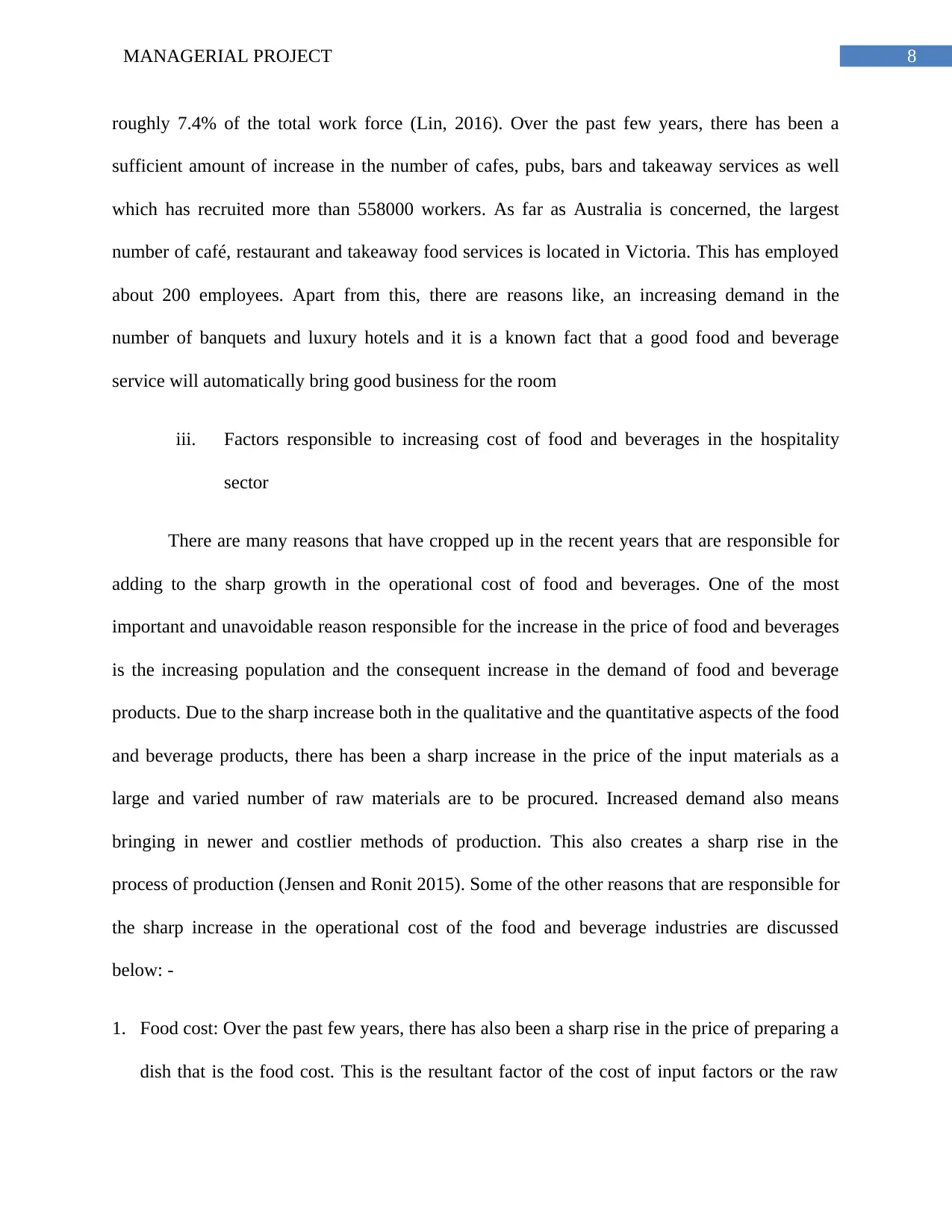
8MANAGERIAL PROJECT
roughly 7.4% of the total work force (Lin, 2016). Over the past few years, there has been a
sufficient amount of increase in the number of cafes, pubs, bars and takeaway services as well
which has recruited more than 558000 workers. As far as Australia is concerned, the largest
number of café, restaurant and takeaway food services is located in Victoria. This has employed
about 200 employees. Apart from this, there are reasons like, an increasing demand in the
number of banquets and luxury hotels and it is a known fact that a good food and beverage
service will automatically bring good business for the room
iii. Factors responsible to increasing cost of food and beverages in the hospitality
sector
There are many reasons that have cropped up in the recent years that are responsible for
adding to the sharp growth in the operational cost of food and beverages. One of the most
important and unavoidable reason responsible for the increase in the price of food and beverages
is the increasing population and the consequent increase in the demand of food and beverage
products. Due to the sharp increase both in the qualitative and the quantitative aspects of the food
and beverage products, there has been a sharp increase in the price of the input materials as a
large and varied number of raw materials are to be procured. Increased demand also means
bringing in newer and costlier methods of production. This also creates a sharp rise in the
process of production (Jensen and Ronit 2015). Some of the other reasons that are responsible for
the sharp increase in the operational cost of the food and beverage industries are discussed
below: -
1. Food cost: Over the past few years, there has also been a sharp rise in the price of preparing a
dish that is the food cost. This is the resultant factor of the cost of input factors or the raw
roughly 7.4% of the total work force (Lin, 2016). Over the past few years, there has been a
sufficient amount of increase in the number of cafes, pubs, bars and takeaway services as well
which has recruited more than 558000 workers. As far as Australia is concerned, the largest
number of café, restaurant and takeaway food services is located in Victoria. This has employed
about 200 employees. Apart from this, there are reasons like, an increasing demand in the
number of banquets and luxury hotels and it is a known fact that a good food and beverage
service will automatically bring good business for the room
iii. Factors responsible to increasing cost of food and beverages in the hospitality
sector
There are many reasons that have cropped up in the recent years that are responsible for
adding to the sharp growth in the operational cost of food and beverages. One of the most
important and unavoidable reason responsible for the increase in the price of food and beverages
is the increasing population and the consequent increase in the demand of food and beverage
products. Due to the sharp increase both in the qualitative and the quantitative aspects of the food
and beverage products, there has been a sharp increase in the price of the input materials as a
large and varied number of raw materials are to be procured. Increased demand also means
bringing in newer and costlier methods of production. This also creates a sharp rise in the
process of production (Jensen and Ronit 2015). Some of the other reasons that are responsible for
the sharp increase in the operational cost of the food and beverage industries are discussed
below: -
1. Food cost: Over the past few years, there has also been a sharp rise in the price of preparing a
dish that is the food cost. This is the resultant factor of the cost of input factors or the raw
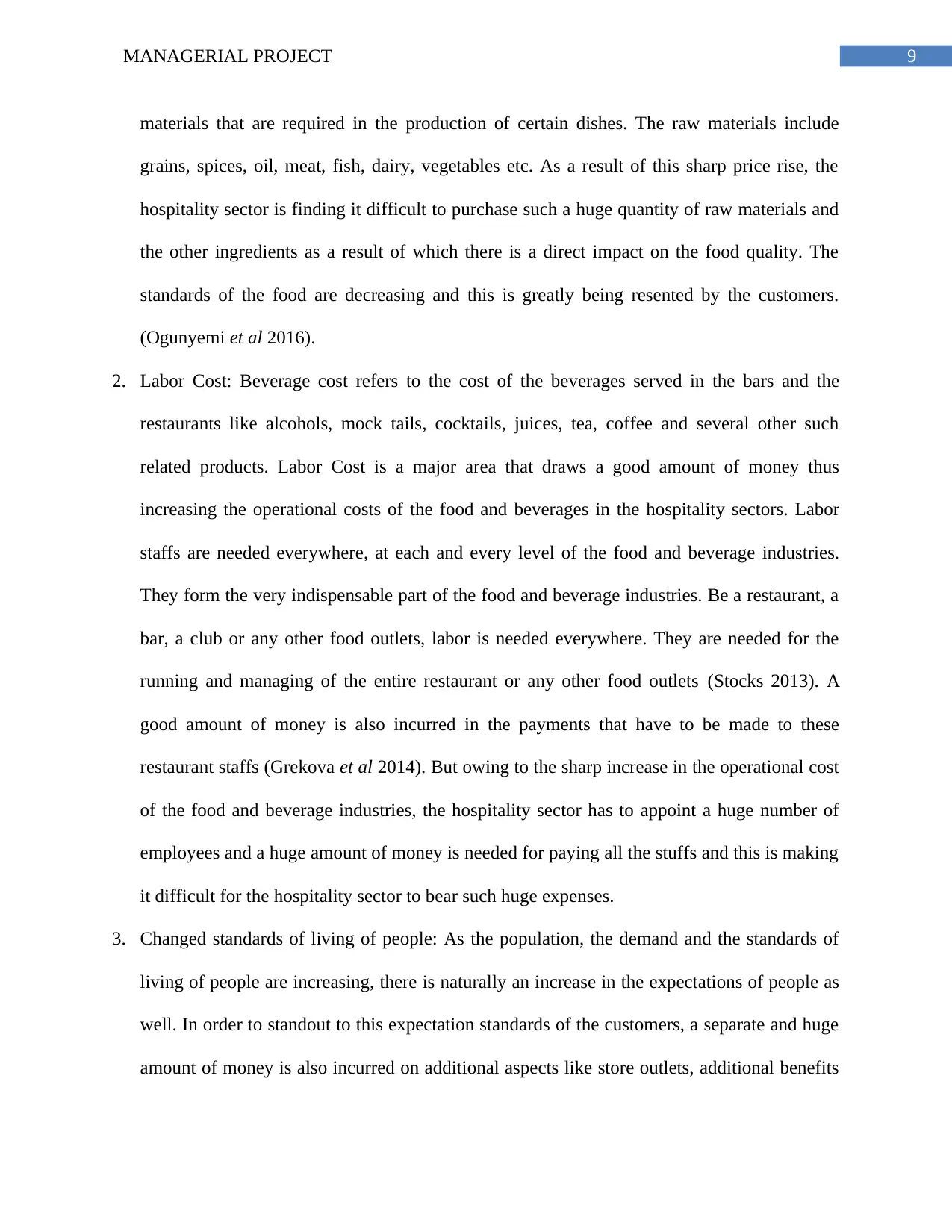
9MANAGERIAL PROJECT
materials that are required in the production of certain dishes. The raw materials include
grains, spices, oil, meat, fish, dairy, vegetables etc. As a result of this sharp price rise, the
hospitality sector is finding it difficult to purchase such a huge quantity of raw materials and
the other ingredients as a result of which there is a direct impact on the food quality. The
standards of the food are decreasing and this is greatly being resented by the customers.
(Ogunyemi et al 2016).
2. Labor Cost: Beverage cost refers to the cost of the beverages served in the bars and the
restaurants like alcohols, mock tails, cocktails, juices, tea, coffee and several other such
related products. Labor Cost is a major area that draws a good amount of money thus
increasing the operational costs of the food and beverages in the hospitality sectors. Labor
staffs are needed everywhere, at each and every level of the food and beverage industries.
They form the very indispensable part of the food and beverage industries. Be a restaurant, a
bar, a club or any other food outlets, labor is needed everywhere. They are needed for the
running and managing of the entire restaurant or any other food outlets (Stocks 2013). A
good amount of money is also incurred in the payments that have to be made to these
restaurant staffs (Grekova et al 2014). But owing to the sharp increase in the operational cost
of the food and beverage industries, the hospitality sector has to appoint a huge number of
employees and a huge amount of money is needed for paying all the stuffs and this is making
it difficult for the hospitality sector to bear such huge expenses.
3. Changed standards of living of people: As the population, the demand and the standards of
living of people are increasing, there is naturally an increase in the expectations of people as
well. In order to standout to this expectation standards of the customers, a separate and huge
amount of money is also incurred on additional aspects like store outlets, additional benefits
materials that are required in the production of certain dishes. The raw materials include
grains, spices, oil, meat, fish, dairy, vegetables etc. As a result of this sharp price rise, the
hospitality sector is finding it difficult to purchase such a huge quantity of raw materials and
the other ingredients as a result of which there is a direct impact on the food quality. The
standards of the food are decreasing and this is greatly being resented by the customers.
(Ogunyemi et al 2016).
2. Labor Cost: Beverage cost refers to the cost of the beverages served in the bars and the
restaurants like alcohols, mock tails, cocktails, juices, tea, coffee and several other such
related products. Labor Cost is a major area that draws a good amount of money thus
increasing the operational costs of the food and beverages in the hospitality sectors. Labor
staffs are needed everywhere, at each and every level of the food and beverage industries.
They form the very indispensable part of the food and beverage industries. Be a restaurant, a
bar, a club or any other food outlets, labor is needed everywhere. They are needed for the
running and managing of the entire restaurant or any other food outlets (Stocks 2013). A
good amount of money is also incurred in the payments that have to be made to these
restaurant staffs (Grekova et al 2014). But owing to the sharp increase in the operational cost
of the food and beverage industries, the hospitality sector has to appoint a huge number of
employees and a huge amount of money is needed for paying all the stuffs and this is making
it difficult for the hospitality sector to bear such huge expenses.
3. Changed standards of living of people: As the population, the demand and the standards of
living of people are increasing, there is naturally an increase in the expectations of people as
well. In order to standout to this expectation standards of the customers, a separate and huge
amount of money is also incurred on additional aspects like store outlets, additional benefits
⊘ This is a preview!⊘
Do you want full access?
Subscribe today to unlock all pages.

Trusted by 1+ million students worldwide
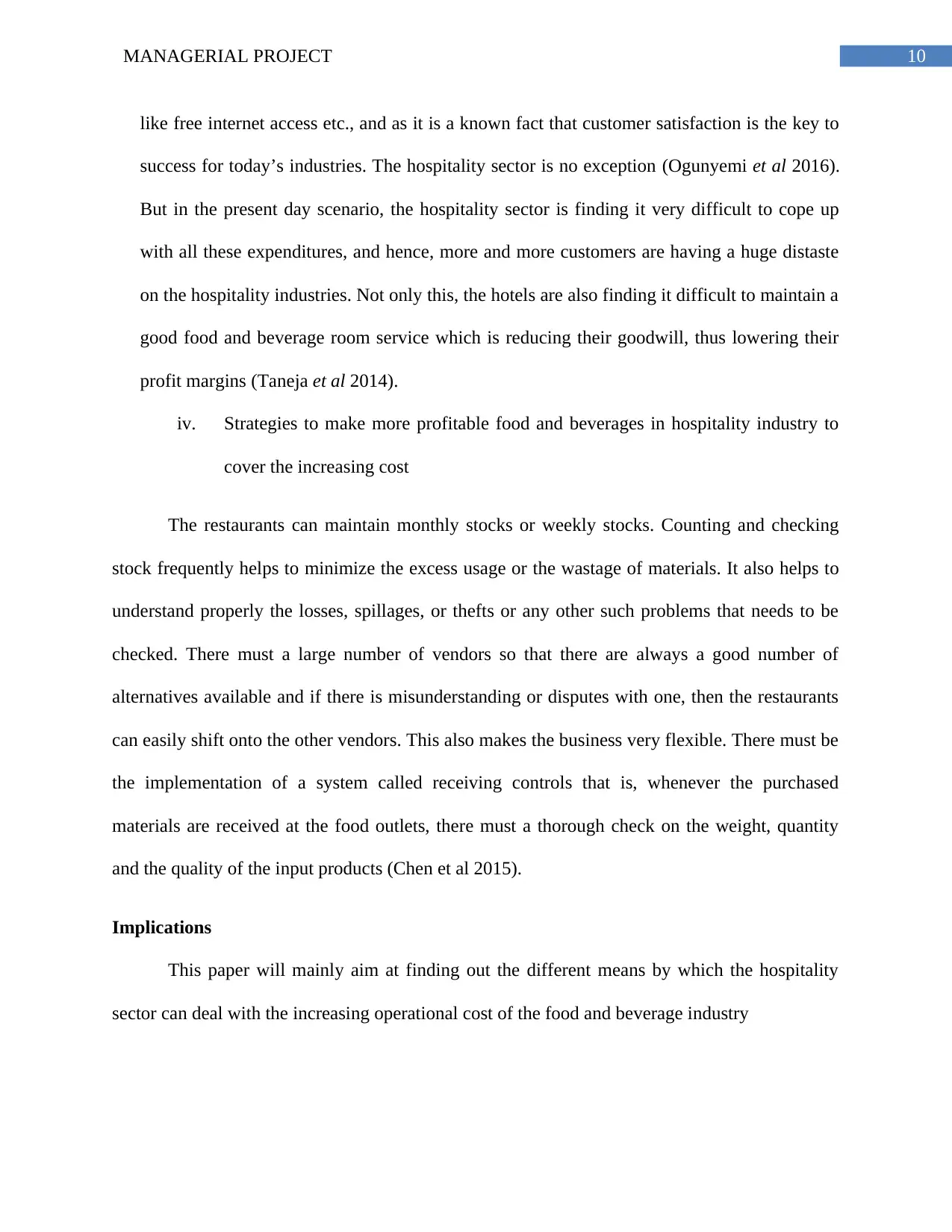
10MANAGERIAL PROJECT
like free internet access etc., and as it is a known fact that customer satisfaction is the key to
success for today’s industries. The hospitality sector is no exception (Ogunyemi et al 2016).
But in the present day scenario, the hospitality sector is finding it very difficult to cope up
with all these expenditures, and hence, more and more customers are having a huge distaste
on the hospitality industries. Not only this, the hotels are also finding it difficult to maintain a
good food and beverage room service which is reducing their goodwill, thus lowering their
profit margins (Taneja et al 2014).
iv. Strategies to make more profitable food and beverages in hospitality industry to
cover the increasing cost
The restaurants can maintain monthly stocks or weekly stocks. Counting and checking
stock frequently helps to minimize the excess usage or the wastage of materials. It also helps to
understand properly the losses, spillages, or thefts or any other such problems that needs to be
checked. There must a large number of vendors so that there are always a good number of
alternatives available and if there is misunderstanding or disputes with one, then the restaurants
can easily shift onto the other vendors. This also makes the business very flexible. There must be
the implementation of a system called receiving controls that is, whenever the purchased
materials are received at the food outlets, there must a thorough check on the weight, quantity
and the quality of the input products (Chen et al 2015).
Implications
This paper will mainly aim at finding out the different means by which the hospitality
sector can deal with the increasing operational cost of the food and beverage industry
like free internet access etc., and as it is a known fact that customer satisfaction is the key to
success for today’s industries. The hospitality sector is no exception (Ogunyemi et al 2016).
But in the present day scenario, the hospitality sector is finding it very difficult to cope up
with all these expenditures, and hence, more and more customers are having a huge distaste
on the hospitality industries. Not only this, the hotels are also finding it difficult to maintain a
good food and beverage room service which is reducing their goodwill, thus lowering their
profit margins (Taneja et al 2014).
iv. Strategies to make more profitable food and beverages in hospitality industry to
cover the increasing cost
The restaurants can maintain monthly stocks or weekly stocks. Counting and checking
stock frequently helps to minimize the excess usage or the wastage of materials. It also helps to
understand properly the losses, spillages, or thefts or any other such problems that needs to be
checked. There must a large number of vendors so that there are always a good number of
alternatives available and if there is misunderstanding or disputes with one, then the restaurants
can easily shift onto the other vendors. This also makes the business very flexible. There must be
the implementation of a system called receiving controls that is, whenever the purchased
materials are received at the food outlets, there must a thorough check on the weight, quantity
and the quality of the input products (Chen et al 2015).
Implications
This paper will mainly aim at finding out the different means by which the hospitality
sector can deal with the increasing operational cost of the food and beverage industry
Paraphrase This Document
Need a fresh take? Get an instant paraphrase of this document with our AI Paraphraser
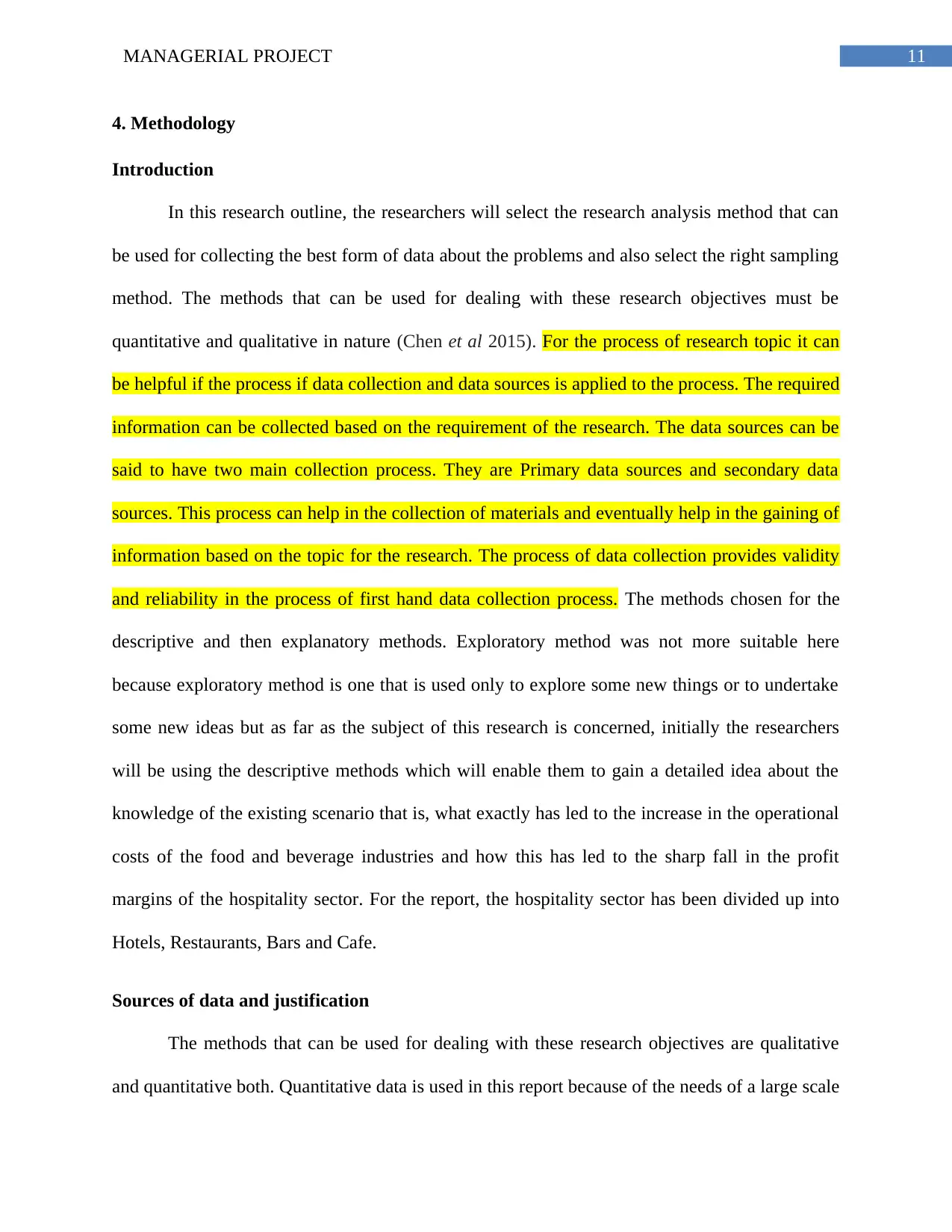
11MANAGERIAL PROJECT
4. Methodology
Introduction
In this research outline, the researchers will select the research analysis method that can
be used for collecting the best form of data about the problems and also select the right sampling
method. The methods that can be used for dealing with these research objectives must be
quantitative and qualitative in nature (Chen et al 2015). For the process of research topic it can
be helpful if the process if data collection and data sources is applied to the process. The required
information can be collected based on the requirement of the research. The data sources can be
said to have two main collection process. They are Primary data sources and secondary data
sources. This process can help in the collection of materials and eventually help in the gaining of
information based on the topic for the research. The process of data collection provides validity
and reliability in the process of first hand data collection process. The methods chosen for the
descriptive and then explanatory methods. Exploratory method was not more suitable here
because exploratory method is one that is used only to explore some new things or to undertake
some new ideas but as far as the subject of this research is concerned, initially the researchers
will be using the descriptive methods which will enable them to gain a detailed idea about the
knowledge of the existing scenario that is, what exactly has led to the increase in the operational
costs of the food and beverage industries and how this has led to the sharp fall in the profit
margins of the hospitality sector. For the report, the hospitality sector has been divided up into
Hotels, Restaurants, Bars and Cafe.
Sources of data and justification
The methods that can be used for dealing with these research objectives are qualitative
and quantitative both. Quantitative data is used in this report because of the needs of a large scale
4. Methodology
Introduction
In this research outline, the researchers will select the research analysis method that can
be used for collecting the best form of data about the problems and also select the right sampling
method. The methods that can be used for dealing with these research objectives must be
quantitative and qualitative in nature (Chen et al 2015). For the process of research topic it can
be helpful if the process if data collection and data sources is applied to the process. The required
information can be collected based on the requirement of the research. The data sources can be
said to have two main collection process. They are Primary data sources and secondary data
sources. This process can help in the collection of materials and eventually help in the gaining of
information based on the topic for the research. The process of data collection provides validity
and reliability in the process of first hand data collection process. The methods chosen for the
descriptive and then explanatory methods. Exploratory method was not more suitable here
because exploratory method is one that is used only to explore some new things or to undertake
some new ideas but as far as the subject of this research is concerned, initially the researchers
will be using the descriptive methods which will enable them to gain a detailed idea about the
knowledge of the existing scenario that is, what exactly has led to the increase in the operational
costs of the food and beverage industries and how this has led to the sharp fall in the profit
margins of the hospitality sector. For the report, the hospitality sector has been divided up into
Hotels, Restaurants, Bars and Cafe.
Sources of data and justification
The methods that can be used for dealing with these research objectives are qualitative
and quantitative both. Quantitative data is used in this report because of the needs of a large scale
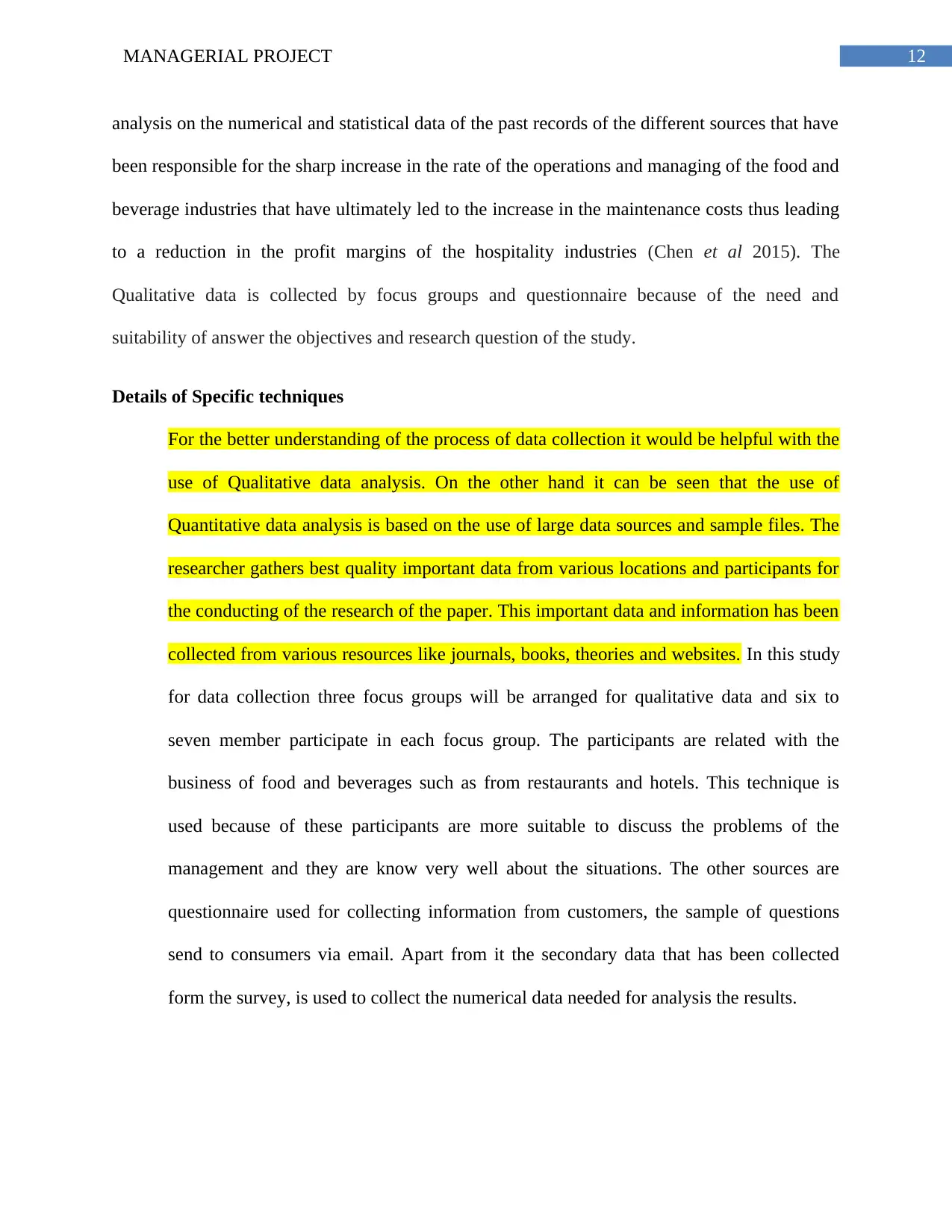
12MANAGERIAL PROJECT
analysis on the numerical and statistical data of the past records of the different sources that have
been responsible for the sharp increase in the rate of the operations and managing of the food and
beverage industries that have ultimately led to the increase in the maintenance costs thus leading
to a reduction in the profit margins of the hospitality industries (Chen et al 2015). The
Qualitative data is collected by focus groups and questionnaire because of the need and
suitability of answer the objectives and research question of the study.
Details of Specific techniques
For the better understanding of the process of data collection it would be helpful with the
use of Qualitative data analysis. On the other hand it can be seen that the use of
Quantitative data analysis is based on the use of large data sources and sample files. The
researcher gathers best quality important data from various locations and participants for
the conducting of the research of the paper. This important data and information has been
collected from various resources like journals, books, theories and websites. In this study
for data collection three focus groups will be arranged for qualitative data and six to
seven member participate in each focus group. The participants are related with the
business of food and beverages such as from restaurants and hotels. This technique is
used because of these participants are more suitable to discuss the problems of the
management and they are know very well about the situations. The other sources are
questionnaire used for collecting information from customers, the sample of questions
send to consumers via email. Apart from it the secondary data that has been collected
form the survey, is used to collect the numerical data needed for analysis the results.
analysis on the numerical and statistical data of the past records of the different sources that have
been responsible for the sharp increase in the rate of the operations and managing of the food and
beverage industries that have ultimately led to the increase in the maintenance costs thus leading
to a reduction in the profit margins of the hospitality industries (Chen et al 2015). The
Qualitative data is collected by focus groups and questionnaire because of the need and
suitability of answer the objectives and research question of the study.
Details of Specific techniques
For the better understanding of the process of data collection it would be helpful with the
use of Qualitative data analysis. On the other hand it can be seen that the use of
Quantitative data analysis is based on the use of large data sources and sample files. The
researcher gathers best quality important data from various locations and participants for
the conducting of the research of the paper. This important data and information has been
collected from various resources like journals, books, theories and websites. In this study
for data collection three focus groups will be arranged for qualitative data and six to
seven member participate in each focus group. The participants are related with the
business of food and beverages such as from restaurants and hotels. This technique is
used because of these participants are more suitable to discuss the problems of the
management and they are know very well about the situations. The other sources are
questionnaire used for collecting information from customers, the sample of questions
send to consumers via email. Apart from it the secondary data that has been collected
form the survey, is used to collect the numerical data needed for analysis the results.
⊘ This is a preview!⊘
Do you want full access?
Subscribe today to unlock all pages.

Trusted by 1+ million students worldwide
1 out of 31
Related Documents
Your All-in-One AI-Powered Toolkit for Academic Success.
+13062052269
info@desklib.com
Available 24*7 on WhatsApp / Email
![[object Object]](/_next/static/media/star-bottom.7253800d.svg)
Unlock your academic potential
Copyright © 2020–2025 A2Z Services. All Rights Reserved. Developed and managed by ZUCOL.




